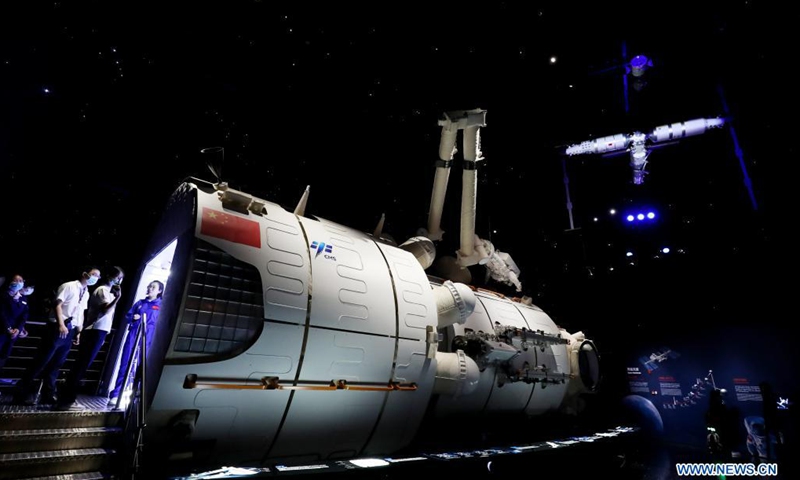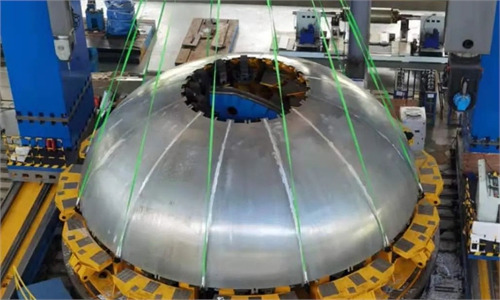
Photo shows the model of China's space station core module Tianhe displayed in Shanghai Astronomy Museum in east China's Shanghai, July 5, 2021. The Shanghai Astronomy Museum, the world's largest planetarium in terms of building scale, will open on July 17, the planetarium announced Monday. The museum is located in the China (Shanghai) Pilot Free Trade Zone Lingang Special Area. It is a branch of the Shanghai Science and Technology Museum.(Photo: Xinhua)
China is studying the in-orbit assembly of an extra-large spacecraft to be developed during the 14th Five-Year Plan (2021-25) period, which is expected to become a major strategic vehicle for its future use of space resources, deep-space explorations and long-term human stays in outer space.
Experts believed that albeit a number of technical and management challenges, the spacecraft could have broad applications, such as the building of a space power plant that will generate electricity for the planet.
The project of assembly mechanics of the mega-sized spacecraft is among the first batch of major projects to be studied in the following five years, according to the project outline recently published by the National Natural Science Foundation of China.
As soon as the news came out, it lit up the Chinese internet, especially among space sci-fi fans. Some thrilled netizens jokingly compared it to the "starships" in movies and TV series. Some pointed out that the Chinese spacecraft, which is designed to be kilometer-level in size, will at least be 10 times the length of the International Space Station (ISS), which is currently the largest spacecraft flying in space.
However, space experts say that there will be a great deal of challenges that must be overcome, apart from the huge demand for manpower and resources, considering the tremendous size and the complexity of the spacecraft, which has greatly exceeded that of the ISS, it will be a challenging project.
According to the project outline, the spacecraft will consist of several modules, which will be launched multiple times and then assembled in space.
Facing a series of issues involved in the process, researchers are tasked to minimize the weight of the modules and the number of launches to reduce construction costs. They will also ensure the controllability of the overall structure, so that attitude drifts, deformation and vibration can be limited during in-orbit assembly.
"Take the ISS as an example. Due to thrust limitations of launching vehicles, it also adopted the approach to assemble the parts in-orbit, which were delivered in separate spaceflights over a number of years," Pang Zhihao, a Beijing-based space expert and retired researcher from the China Academy of Space Technology, told the Global Times on Wednesday.
"It took the ISS 12 years - from 1998 to 2010 - to finally complete the construction. And by the time of completion, the first module that was launched more than a decade prior had almost reached its lifespan. So it can be speculated that the kilometer-level spacecraft will take even longer to build, and will have much higher requirements for the lifespan of its core components, and the ability to replace components flexibly," Pang said.
The complexity not only rests on technical issues, but also the overall planning and management of the project, he added, and we must also consider the threats of space debris, which is almost inevitable to avoid for a spacecraft as large as this, Pang noted.
However, experts stressed that while the difficulties to construct such a spacecraft are great, it has a broad application prospect. For example, it can be used for building a space power plant, enabling a large-scale all-weather power generation from space to Earth's ground by transferring solar powers to electricity.
China made some major breakthroughs in developing its new super-heavy-lift carrier rocket earlier this month, rolling out the country's first 9.5-meter-diameter rocket tank bottom and liquid booster engine.
The launch vehicle may point to the Long March 9 carrier rocket, which will be used for future crewed lunar missions, deep space exploration and space infrastructure, Wang Ya'nan, editor-in-chief of Aerospace Knowledge magazine, told the Global Times.

